初中英语教案—名词
- 格式:doc
- 大小:67.00 KB
- 文档页数:6
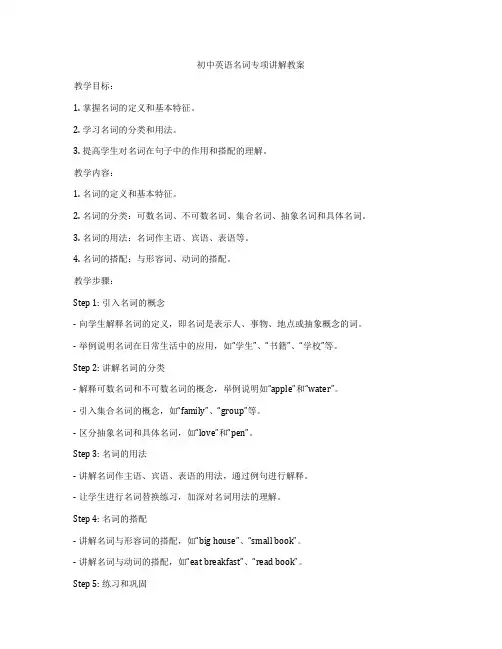
初中英语名词专项讲解教案教学目标:1. 掌握名词的定义和基本特征。
2. 学习名词的分类和用法。
3. 提高学生对名词在句子中的作用和搭配的理解。
教学内容:1. 名词的定义和基本特征。
2. 名词的分类:可数名词、不可数名词、集合名词、抽象名词和具体名词。
3. 名词的用法:名词作主语、宾语、表语等。
4. 名词的搭配:与形容词、动词的搭配。
教学步骤:Step 1: 引入名词的概念- 向学生解释名词的定义,即名词是表示人、事物、地点或抽象概念的词。
- 举例说明名词在日常生活中的应用,如“学生”、“书籍”、“学校”等。
Step 2: 讲解名词的分类- 解释可数名词和不可数名词的概念,举例说明如“apple”和“water”。
- 引入集合名词的概念,如“family”、“group”等。
- 区分抽象名词和具体名词,如“love”和“pen”。
Step 3: 名词的用法- 讲解名词作主语、宾语、表语的用法,通过例句进行解释。
- 让学生进行名词替换练习,加深对名词用法的理解。
Step 4: 名词的搭配- 讲解名词与形容词的搭配,如“big house”、“small book”。
- 讲解名词与动词的搭配,如“eat breakfast”、“read book”。
Step 5: 练习和巩固- 提供一些练习题,让学生区分名词的分类和用法。
- 让学生进行句子创作,运用所学的名词知识。
Step 6: 总结和复习- 对本节课的内容进行总结,强调名词的重要性和用法。
- 回答学生的疑问,进行复习和巩固。
教学评价:- 通过课堂参与、练习题和句子创作等方式评估学生对名词的理解和运用能力。
- 观察学生在课堂上的积极参与情况和练习的正确率,对学生的学习效果进行评价。
教学资源:- 名词的定义和分类的PPT或黑板。
- 练习题和句子创作的模板。
教学建议:- 在讲解名词的分类时,可以通过实物展示或图片来帮助学生更好地理解和记忆。
- 在讲解名词的用法时,可以通过例句和练习题来引导学生进行思考和运用。

名词语法英文版教案(总24页) -CAL-FENGHAI.-(YICAI)-Company One1-CAL-本页仅作为文档封面,使用请直接删除名词语法英文版教案【篇一:初中英语语法教案大全】初中英语语法大全名词(一)概述名词是表示人、地方、事物或抽象概念名称的词,可以说名词是万物之名称。
它们可以是:人的名字 li ming, tom 地方名称 china, london 职业称呼 teacher, doctor物品名称 pencil, dictionary 行为名称 study, invention抽象概念history, grammar(二)普通名词和专有名词1.普通名词凡不属于特定的人名、地名、事物名称或概念名称的名词,都属于普通名词。
这类名词在所有的名词中占绝大多数。
普通名词大致有以下四种类型:1)个体名词个体名词指作为个体而存在的人或物。
可以指具体的人或物,例如:他有两个姑姑。
多数教室里都有电脑。
也可指抽象东西,例如: we?ve lived here for twenty years. 我们在这里住了二十年了。
我昨晚做了一个梦。
个体名词有复数形式,如:weeks, problems;单数形式可以和a/an 连用,如:a week, a problem, an old man.2)集体名词集体名词表示由个体组成的集体,下面是一些常见的集体名词:family(家,家庭) army(军队) company(公司;全体船员)enemy(敌人) government(政府) group(小组,团体) public (公众) team(队;组) police(警方)集体名词有时作单数看待,有时作复数看待。
一般说来,视为整体时作单数看待,想到它的成员时有的集体名词通常用作单数,例如:我们公司将派他去柏林工作。
有的集体名词多作复数看待。
例如:警察正在找他。
3)物质名词物质名词指无法分为个体的东西,我们学过的常见的物质名词有:beer, cloth, coal, coffee, coke, cotton, ice, ink, jam, juice, meat, medicine, metal, milk, oil paper, rain, salad, salt, sand, snow, soup, steel, sugar, tea, water, wine, wood, wool等。
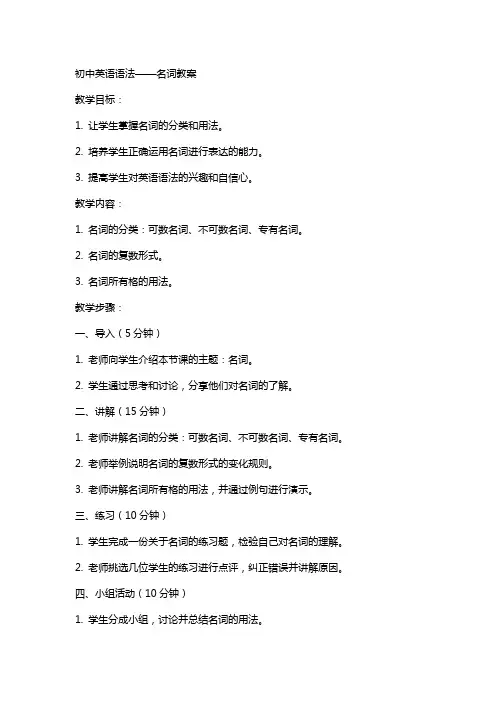
初中英语语法——名词教案教学目标:1. 让学生掌握名词的分类和用法。
2. 培养学生正确运用名词进行表达的能力。
3. 提高学生对英语语法的兴趣和自信心。
教学内容:1. 名词的分类:可数名词、不可数名词、专有名词。
2. 名词的复数形式。
3. 名词所有格的用法。
教学步骤:一、导入(5分钟)1. 老师向学生介绍本节课的主题:名词。
2. 学生通过思考和讨论,分享他们对名词的了解。
二、讲解(15分钟)1. 老师讲解名词的分类:可数名词、不可数名词、专有名词。
2. 老师举例说明名词的复数形式的变化规则。
3. 老师讲解名词所有格的用法,并通过例句进行演示。
三、练习(10分钟)1. 学生完成一份关于名词的练习题,检验自己对名词的理解。
2. 老师挑选几位学生的练习进行点评,纠正错误并讲解原因。
四、小组活动(10分钟)1. 学生分成小组,讨论并总结名词的用法。
2. 每个小组选一位代表进行汇报,其他小组成员补充。
五、总结(5分钟)1. 老师引导学生回顾本节课所学内容,总结名词的分类、复数形式和所有格的用法。
2. 学生分享自己在课堂上的收获和感受。
教学评价:1. 通过课后作业和测试,检查学生对名词知识的掌握程度。
2. 观察学生在课堂上的参与度和小组活动中的表现,评估他们的学习效果。
六、案例分析与应用(10分钟)1. 老师展示一些含有名词的句子,让学生识别并解释其中的名词。
2. 学生分析句子中名词的作用和语法功能。
3. 老师引导学生运用所学知识,分析并解决实际生活中的名词用法问题。
七、拓展训练(10分钟)1. 学生完成一份关于名词的拓展练习,巩固所学知识。
2. 老师挑选几位学生的练习进行点评,纠正错误并讲解原因。
3. 老师鼓励学生多进行名词的练习,提高自己的语法水平。
八、课堂小结(5分钟)1. 老师引导学生回顾本节课的学习内容,总结名词的分类、复数形式和所有格的用法。
2. 学生分享自己在课堂上的收获和感受。
九、课后作业(布置作业)1. 学生完成一份关于名词的课后作业,巩固所学知识。
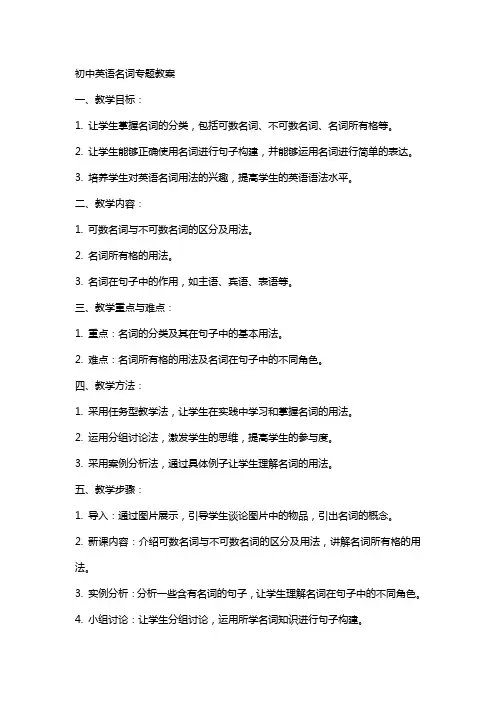
初中英语名词专题教案一、教学目标:1. 让学生掌握名词的分类,包括可数名词、不可数名词、名词所有格等。
2. 让学生能够正确使用名词进行句子构建,并能够运用名词进行简单的表达。
3. 培养学生对英语名词用法的兴趣,提高学生的英语语法水平。
二、教学内容:1. 可数名词与不可数名词的区分及用法。
2. 名词所有格的用法。
3. 名词在句子中的作用,如主语、宾语、表语等。
三、教学重点与难点:1. 重点:名词的分类及其在句子中的基本用法。
2. 难点:名词所有格的用法及名词在句子中的不同角色。
四、教学方法:1. 采用任务型教学法,让学生在实践中学习和掌握名词的用法。
2. 运用分组讨论法,激发学生的思维,提高学生的参与度。
3. 采用案例分析法,通过具体例子让学生理解名词的用法。
五、教学步骤:1. 导入:通过图片展示,引导学生谈论图片中的物品,引出名词的概念。
2. 新课内容:介绍可数名词与不可数名词的区分及用法,讲解名词所有格的用法。
3. 实例分析:分析一些含有名词的句子,让学生理解名词在句子中的不同角色。
4. 小组讨论:让学生分组讨论,运用所学名词知识进行句子构建。
5. 课堂练习:设计一些练习题,让学生巩固所学知识。
六、教学活动:1. 复习上节课所学的名词知识,通过问答方式检查学生的掌握情况。
2. 进行一场小游戏,让学生在游戏中运用名词进行表达,增强学生的实践能力。
七、课堂练习:1. 设计一些练习题,包括选择题、填空题和改错题,让学生巩固所学知识。
2. 挑选一些学生的练习进行点评,指出其中的错误并提供正确答案。
八、拓展知识:1. 介绍一些与名词相关的语法点,如名词的数、格等。
2. 通过案例分析,让学生了解名词在复杂句子中的用法,提高学生的语法水平。
九、课后作业:1. 布置一些课后练习题,要求学生按时完成。
2. 鼓励学生在生活中多运用所学名词知识,提高学生的实际运用能力。
十、教学反思:2. 根据学生的反馈,调整教学方法,为下一节课的教学做好准备。
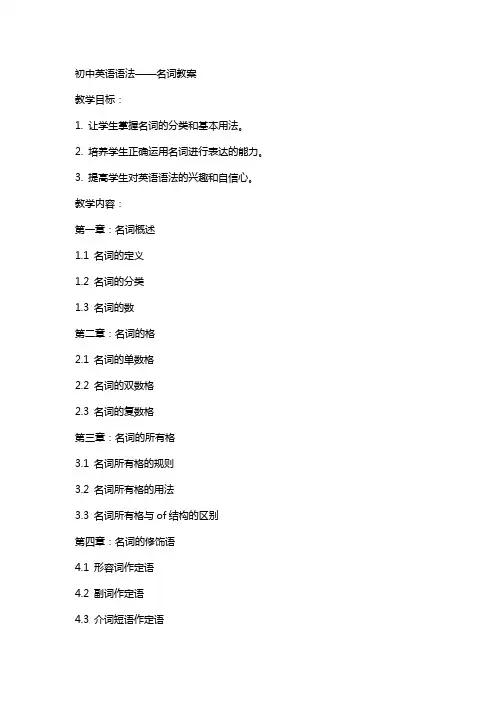
初中英语语法——名词教案教学目标:1. 让学生掌握名词的分类和基本用法。
2. 培养学生正确运用名词进行表达的能力。
3. 提高学生对英语语法的兴趣和自信心。
教学内容:第一章:名词概述1.1 名词的定义1.2 名词的分类1.3 名词的数第二章:名词的格2.1 名词的单数格2.2 名词的双数格2.3 名词的复数格第三章:名词的所有格3.1 名词所有格的规则3.2 名词所有格的用法3.3 名词所有格与of结构的区别第四章:名词的修饰语4.1 形容词作定语4.2 副词作定语4.3 介词短语作定语第五章:名词的搭配关系5.1 名词与形容词的搭配5.2 名词与动词的搭配5.3 名词与介词的搭配教学过程:一、导入(5分钟)1. 引导学生回顾已学的词汇,如动物、植物、家庭成员等。
2. 提问:这些词汇在句子中是如何使用的?二、讲解(20分钟)1. 第一章:介绍名词的定义、分类和数。
a. 举例说明名词的分类:人物名词、地点名词、物质名词等。
b. 讲解名词的数:单数和复数。
c. 练习:填空、选择题。
2. 第二章:讲解名词的格。
a. 单数格、双数格和复数格的表示方法。
b. 举例说明名词格的变化规律。
c. 练习:填空、选择题。
3. 第三章:介绍名词的所有格。
a. 讲解名词所有格的规则。
b. 举例说明名词所有格的用法。
c. 对比名词所有格与of结构的区别。
d. 练习:填空、选择题。
4. 第四章:讲解名词的修饰语。
a. 介绍形容词、副词和介词短语作定语的用法。
b. 举例说明不同修饰语对名词的影响。
c. 练习:填空、选择题。
5. 第五章:讲解名词的搭配关系。
a. 举例说明名词与形容词、动词、介词的搭配。
b. 引导学生注意名词搭配的重要性。
c. 练习:填空、选择题。
三、练习(15分钟)1. 根据所学的知识点,完成练习题。
2. 学生互相批改,教师讲解答案。
四、总结(5分钟)1. 回顾本节课所学的内容。
2. 提问:名词在句子中的作用是什么?3. 提醒学生注意名词的搭配和修饰语的使用。
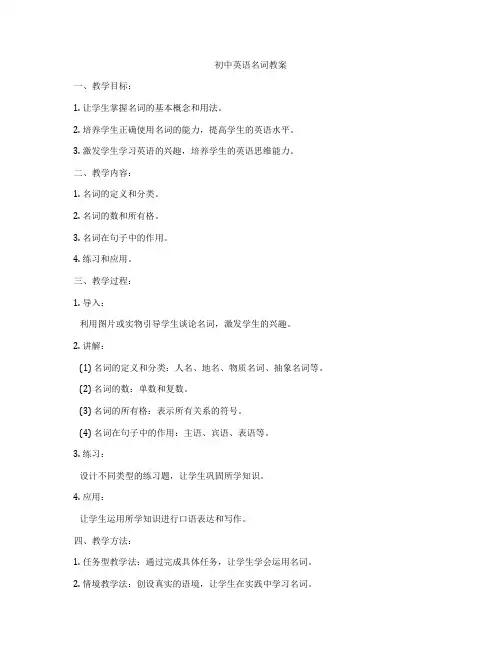
初中英语名词教案一、教学目标:1. 让学生掌握名词的基本概念和用法。
2. 培养学生正确使用名词的能力,提高学生的英语水平。
3. 激发学生学习英语的兴趣,培养学生的英语思维能力。
二、教学内容:1. 名词的定义和分类。
2. 名词的数和所有格。
3. 名词在句子中的作用。
4. 练习和应用。
三、教学过程:1. 导入:利用图片或实物引导学生谈论名词,激发学生的兴趣。
2. 讲解:(1) 名词的定义和分类:人名、地名、物质名词、抽象名词等。
(2) 名词的数:单数和复数。
(3) 名词的所有格:表示所有关系的符号。
(4) 名词在句子中的作用:主语、宾语、表语等。
3. 练习:设计不同类型的练习题,让学生巩固所学知识。
4. 应用:让学生运用所学知识进行口语表达和写作。
四、教学方法:1. 任务型教学法:通过完成具体任务,让学生学会运用名词。
2. 情境教学法:创设真实的语境,让学生在实践中学习名词。
3. 互动式教学法:鼓励学生积极参与,提高学生的学习积极性。
五、教学评价:1. 课堂参与度:观察学生在课堂上的发言和表现。
2. 练习正确率:检查学生完成练习题的正确率。
3. 应用能力:评估学生在口语表达和写作中的运用能力。
六、教学资源:1. 图片或实物:用于引导学生谈论名词。
2. 练习题:用于巩固所学知识。
3. 教学课件:辅助讲解和展示名词的相关知识。
七、教学时间:1课时(40分钟)八、课后作业:1. 复习名词的基本概念和用法。
2. 完成课后练习题。
3. 尝试在日常生活和学习中运用所学知识。
通过本节课的教学,使学生掌握名词的基本概念和用法,提高学生正确使用名词的能力,为后续学习打下基础。
同时,注重培养学生的英语思维能力,激发学生学习英语的兴趣。
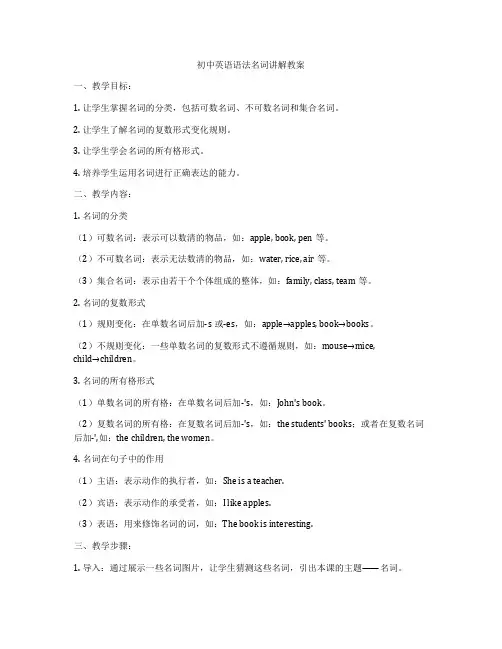
初中英语语法名词讲解教案一、教学目标:1. 让学生掌握名词的分类,包括可数名词、不可数名词和集合名词。
2. 让学生了解名词的复数形式变化规则。
3. 让学生学会名词的所有格形式。
4. 培养学生运用名词进行正确表达的能力。
二、教学内容:1. 名词的分类(1)可数名词:表示可以数清的物品,如:apple, book, pen等。
(2)不可数名词:表示无法数清的物品,如:water, rice, air等。
(3)集合名词:表示由若干个个体组成的整体,如:family, class, team等。
2. 名词的复数形式(1)规则变化:在单数名词后加-s或-es,如:apple→apples, book→books。
(2)不规则变化:一些单数名词的复数形式不遵循规则,如:mouse→mice,child→children。
3. 名词的所有格形式(1)单数名词的所有格:在单数名词后加-'s,如:John's book。
(2)复数名词的所有格:在复数名词后加-'s,如:the students' books;或者在复数名词后加-',如:the children, the women。
4. 名词在句子中的作用(1)主语:表示动作的执行者,如:She is a teacher.(2)宾语:表示动作的承受者,如:I like apples.(3)表语:用来修饰名词的词,如:The book is interesting.三、教学步骤:1. 导入:通过展示一些名词图片,让学生猜测这些名词,引出本课的主题——名词。
2. 讲解:(1)介绍名词的分类,让学生举例说明。
(2)讲解名词的复数形式变化规则,引导学生注意不规则变化。
(3)讲解名词的所有格形式,让学生区分单数和复数的所有格。
3. 练习:(1)让学生用所学的名词分类知识,将给出的单词归类。
(2)让学生根据所学的名词复数形式变化规则,将单词变为复数形式。
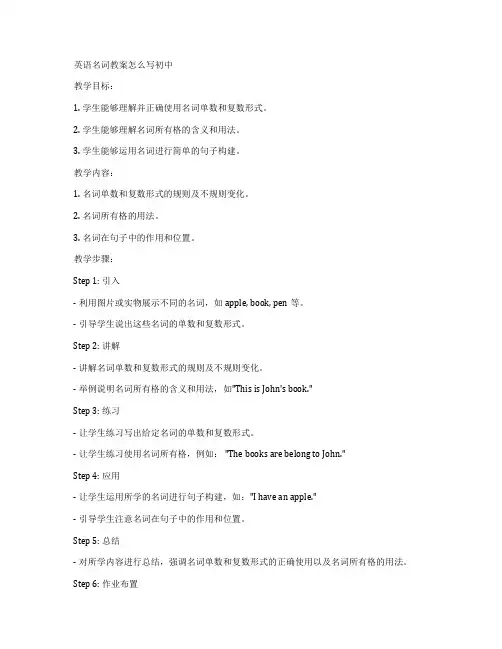
英语名词教案怎么写初中教学目标:1. 学生能够理解并正确使用名词单数和复数形式。
2. 学生能够理解名词所有格的含义和用法。
3. 学生能够运用名词进行简单的句子构建。
教学内容:1. 名词单数和复数形式的规则及不规则变化。
2. 名词所有格的用法。
3. 名词在句子中的作用和位置。
教学步骤:Step 1: 引入- 利用图片或实物展示不同的名词,如apple, book, pen等。
- 引导学生说出这些名词的单数和复数形式。
Step 2: 讲解- 讲解名词单数和复数形式的规则及不规则变化。
- 举例说明名词所有格的含义和用法,如"This is John's book."Step 3: 练习- 让学生练习写出给定名词的单数和复数形式。
- 让学生练习使用名词所有格,例如: "The books are belong to John."Step 4: 应用- 让学生运用所学的名词进行句子构建,如:"I have an apple."- 引导学生注意名词在句子中的作用和位置。
Step 5: 总结- 对所学内容进行总结,强调名词单数和复数形式的正确使用以及名词所有格的用法。
Step 6: 作业布置- 布置练习题,让学生巩固所学内容,如:填空题、选择题等。
教学评价:1. 通过课堂练习和作业,评估学生对名词单数和复数形式的掌握情况。
2. 通过句子构建练习,评估学生对名词所有格的运用能力。
3. 通过课堂讨论和问答,评估学生对名词在句子中作用和位置的理解程度。
教学资源:1. 图片或实物。
2. 练习题。
3. 教学PPT或黑板。
教学反思:在课后,教师应反思本次教学的效果,根据学生的反馈和表现,调整教学方法和策略,以提高学生的英语名词水平。
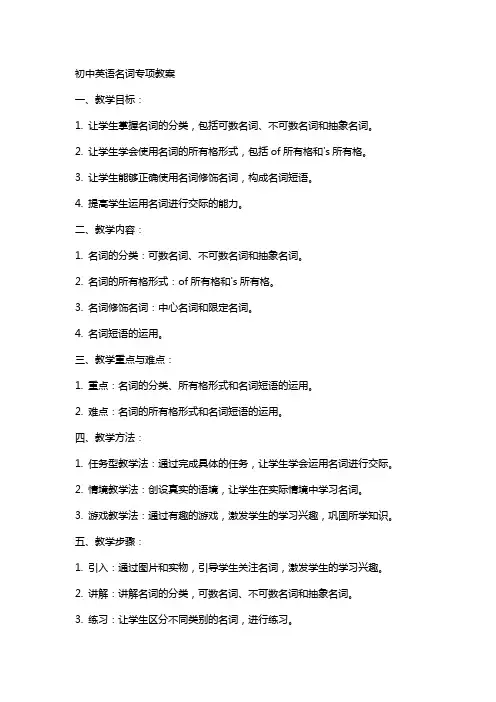
初中英语名词专项教案一、教学目标:1. 让学生掌握名词的分类,包括可数名词、不可数名词和抽象名词。
2. 让学生学会使用名词的所有格形式,包括of所有格和's所有格。
3. 让学生能够正确使用名词修饰名词,构成名词短语。
4. 提高学生运用名词进行交际的能力。
二、教学内容:1. 名词的分类:可数名词、不可数名词和抽象名词。
2. 名词的所有格形式:of所有格和's所有格。
3. 名词修饰名词:中心名词和限定名词。
4. 名词短语的运用。
三、教学重点与难点:1. 重点:名词的分类、所有格形式和名词短语的运用。
2. 难点:名词的所有格形式和名词短语的运用。
四、教学方法:1. 任务型教学法:通过完成具体的任务,让学生学会运用名词进行交际。
2. 情境教学法:创设真实的语境,让学生在实际情境中学习名词。
3. 游戏教学法:通过有趣的游戏,激发学生的学习兴趣,巩固所学知识。
五、教学步骤:1. 引入:通过图片和实物,引导学生关注名词,激发学生的学习兴趣。
2. 讲解:讲解名词的分类,可数名词、不可数名词和抽象名词。
3. 练习:让学生区分不同类别的名词,进行练习。
4. 讲解:讲解名词的所有格形式,of所有格和's所有格。
5. 练习:让学生运用所有格形式,进行练习。
6. 讲解:讲解名词修饰名词,中心名词和限定名词。
7. 练习:让学生运用名词修饰名词,构成名词短语。
8. 讲解:讲解名词短语的运用,如何正确使用。
9. 练习:让学生在实际情境中,运用名词短语。
10. 总结:对本节课所学内容进行总结,让学生掌握名词的分类、所有格形式和名词短语的运用。
11. 作业布置:布置相关练习题,让学生巩固所学知识。
六、教学评估:1. 课堂参与度:观察学生在课堂活动中的参与程度,了解他们对名词知识的掌握情况。
2. 练习正确性:评估学生在练习中的正确率,检验他们对名词分类、所有格形式和名词短语的掌握程度。
3. 小组讨论:通过小组讨论的方式,了解学生在合作中的交流和运用名词的能力。
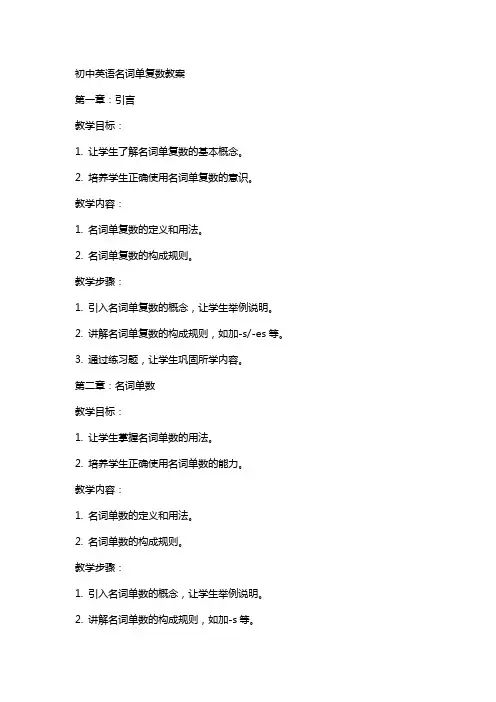
初中英语名词单复数教案第一章:引言教学目标:1. 让学生了解名词单复数的基本概念。
2. 培养学生正确使用名词单复数的意识。
教学内容:1. 名词单复数的定义和用法。
2. 名词单复数的构成规则。
教学步骤:1. 引入名词单复数的概念,让学生举例说明。
2. 讲解名词单复数的构成规则,如加-s/-es等。
3. 通过练习题,让学生巩固所学内容。
第二章:名词单数教学目标:1. 让学生掌握名词单数的用法。
2. 培养学生正确使用名词单数的能力。
教学内容:1. 名词单数的定义和用法。
2. 名词单数的构成规则。
教学步骤:1. 引入名词单数的概念,让学生举例说明。
2. 讲解名词单数的构成规则,如加-s等。
第三章:名词复数教学目标:1. 让学生掌握名词复数的用法。
2. 培养学生正确使用名词复数的能力。
教学内容:1. 名词复数的定义和用法。
2. 名词复数的构成规则。
教学步骤:1. 引入名词复数的概念,让学生举例说明。
2. 讲解名词复数的构成规则,如加-s/-es等。
3. 通过练习题,让学生巩固所学内容。
第四章:名词单复数的辨析教学目标:1. 让学生能够正确辨析名词单复数。
2. 培养学生正确使用名词单复数的能力。
教学内容:1. 名词单复数的辨析方法。
2. 名词单复数的常用搭配。
教学步骤:1. 讲解名词单复数的辨析方法,如根据上下文判断。
2. 举例说明名词单复数的常用搭配,如“books and magazines”。
第五章:总结与拓展教学目标:1. 让学生总结所学内容,加深对名词单复数的理解。
2. 培养学生运用名词单复数进行实际交流的能力。
教学内容:1. 总结名词单复数的概念、用法和辨析方法。
2. 拓展名词单复数的相关知识,如不规则变化的名词复数等。
教学步骤:1. 让学生总结所学内容,加深对名词单复数的理解。
2. 讲解不规则变化的名词复数,如“child-children”。
3. 通过练习题,让学生巩固所学内容。
第六章:名词所有格教学目标:1. 让学生掌握名词所有格的用法。
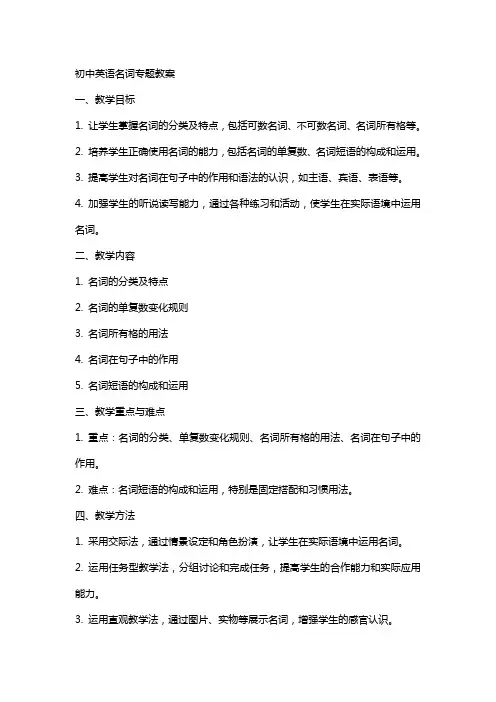
初中英语名词专题教案一、教学目标1. 让学生掌握名词的分类及特点,包括可数名词、不可数名词、名词所有格等。
2. 培养学生正确使用名词的能力,包括名词的单复数、名词短语的构成和运用。
3. 提高学生对名词在句子中的作用和语法的认识,如主语、宾语、表语等。
4. 加强学生的听说读写能力,通过各种练习和活动,使学生在实际语境中运用名词。
二、教学内容1. 名词的分类及特点2. 名词的单复数变化规则3. 名词所有格的用法4. 名词在句子中的作用5. 名词短语的构成和运用三、教学重点与难点1. 重点:名词的分类、单复数变化规则、名词所有格的用法、名词在句子中的作用。
2. 难点:名词短语的构成和运用,特别是固定搭配和习惯用法。
四、教学方法1. 采用交际法,通过情景设定和角色扮演,让学生在实际语境中运用名词。
2. 运用任务型教学法,分组讨论和完成任务,提高学生的合作能力和实际应用能力。
3. 运用直观教学法,通过图片、实物等展示名词,增强学生的感官认识。
4. 运用语法讲解法,清晰讲解名词的分类、单复数变化规则等,确保学生掌握基础知识。
五、教学准备1. 教学PPT,包含名词的分类、特点、单复数变化规则、名词所有格等知识点。
2. 教学素材,如图片、实物、例句等。
3. 练习题,包括选择题、填空题、翻译题等,用于巩固所学知识。
4. 分组任务,让学生在课堂上进行合作和讨论。
六、教学步骤1. 导入:通过展示一幅图片或一个实物,引导学生说出相应的名词,引出本课主题。
2. 讲解:详细讲解名词的分类、特点、单复数变化规则、名词所有格等基本知识。
3. 示例:给出典型例句,展示名词在句子中的不同作用,如主语、宾语、表语等。
4. 练习:让学生完成一些选择题、填空题等,检查他们对名词知识的掌握程度。
5. 活动:组织学生进行小组活动,如讨论、角色扮演等,让学生在实际语境中运用名词。
七、课堂练习1. 选择题:判断下列句子中画线名词的词性和作用。
2. 填空题:根据语境,填入适当的名词形式。
初中英语名词教案教案标题:探索初中英语名词的教学教学目标:1. 理解名词的基本定义和功能。
2. 掌握常见名词的分类和用法。
3. 能够准确使用名词构建句子和进行语境交流。
教学重点:1. 名词的定义和基本功能。
2. 名词的分类及其不同用法。
3. 名词在句子中的运用。
教学准备:1. 教学课件和投影仪。
2. 白板和标记笔。
3. 练习题和答案。
教学过程:Step 1: 引入1. 利用图片或实物引入名词的概念,让学生猜测物品的名称,并解释什么是名词。
2. 使用简单的句子和图片示范名词在句子中的使用。
Step 2: 名词的分类和用法1. 教师介绍名词的分类(可数名词和不可数名词、专有名词和普通名词等)。
2. 利用课件和示例句子,说明不同类别名词的用法和语法规则。
3. 引导学生分辨不同类别名词,并进行练习。
Step 3: 名词在句子中的运用1. 介绍名词在句子中的基本作用,如主语、宾语、表语等。
2. 利用课件和示例句子,展示名词在不同位置的运用。
3. 让学生通过完成句子或改写句子的练习,加深对名词在句子中的理解。
Step 4: 练习与巩固1. 提供练习题,让学生进行名词的分类和句子构建练习。
2. 逐步增加难度,引导学生运用所学名词进行对话或写作练习。
3. 教师检查学生的练习并给予必要的指导和反馈。
Step 5: 总结与拓展1. 教师对本节课进行总结,强调名词的重要性和正确使用的方法。
2. 鼓励学生在日常学习和交流中注意名词的运用。
3. 提供额外的练习题或阅读材料,帮助学生巩固所学内容。
教学评价与反馈:1. 教师通过观察学生的课堂表现,包括回答问题和参与活动的积极程度,对学生进行评价。
2. 对学生的书面作业进行批改,给予必要的反馈和建议。
3. 在下节课开始时,对学生的掌握情况进行简要复习和检验。
拓展活动:1. 利用互动游戏或角色扮演活动,让学生在更具趣味性的情境中练习名词的运用。
2. 通过音频或视频材料,让学生观察、听取并记录名词的使用情况。
初中英语语法讲解教案课程名称:初中英语语法——名词课时:2课时教学目标:1. 掌握名词的分类、数、所有格、句法功能等相关知识。
2. 能通过自己归纳总结与名词有关的语法规则。
3. 能灵活按照语法规则使用名词。
教学重点:1. 掌握名词的分类、数、所有格、句法功能等相关知识。
2. 能灵活使用名词。
教学难点:1. 名词变复数的不规则变化。
2. 名词所有格的变化形式。
教学方法:引导探究法教学准备:PPT教学过程:第一课时:一、复习旧知1. 复习十大词类:英语中有哪些此类呢?(名词、动词、形容词、副词、代词、数词、冠词、介词、连词、叹词)2. 英语中使用最多的是什么词呢?(英语中使用最多的是名词和动词,其次是形容词、副词、代词、数词、冠词、介词、连词、叹词)二、导入1. 大家知道什么是名词吗?随便说几个名词。
(pen, table, blackboard)2. 介绍名词的分类、数、所有格、句法功能等相关知识。
三、名词的分类1. 个体名词:表示单独的人或事物,如:boy, book。
2. 集体名词:表示一群人或事物,如:family, group。
3. 物质名词:表示物质或材料,如:water, paper。
4. 抽象名词:表示概念、品质、情感等,如:love, happiness。
四、名词的数1. 单数:表示一个事物,如:book, girl。
2. 复数:表示两个或两个以上的事物,如:books, girls。
五、名词的所有格1. 单数名词的所有格:在名词后加's,如:Tom's book。
2. 复数名词的所有格:在名词后加's,如:the boys' books。
3. 表示两者共同所有时,用'and'连接,如:Tom and John's books。
第二课时:一、复习上节课的内容1. 复习名词的分类、数、所有格等相关知识。
2. 学生举例练习,教师点评。
初中生英语名词讲解教案教学目标:1. 让学生掌握名词的定义和基本用法。
2. 让学生学会使用名词进行正确的句子构建。
3. 培养学生对英语名词的兴趣和理解能力。
教学内容:1. 名词的定义和分类。
2. 名词的数和格。
3. 名词在句子中的作用。
4. 练习和应用。
教学步骤:Step 1: 引入名词的概念- 向学生解释名词的定义,即表示人、事物、地点或抽象概念的词。
- 举例说明,如:boy, girl, book, table, happiness等。
Step 2: 名词的分类- 解释名词可以分为可数名词和不可数名词。
- 可数名词表示可以数的事物,如:apples, cars等。
- 不可数名词表示无法数的事物,如:water, air等。
Step 3: 名词的数- 讲解名词的复数形式,如:boy - boys, book - books等。
- 强调复数形式的变化规则,如: add - s, add - es, change y to i and add - es等。
Step 4: 名词的格- 讲解名词的格,包括主格、宾格和所有格。
- 主格表示名词作为主语,如:The book is interesting.- 宾格表示名词作为宾语,如:I read a book.- 所有格表示名词的所有权,如:This is my book.Step 5: 名词在句子中的作用- 讲解名词在句子中的不同作用,如主语、宾语、表语等。
- 举例说明,如:The cat (主语) is sleeping.I like (宾语) apples.He is a (表语) teacher.Step 6: 练习和应用- 提供一些练习题,让学生区分可数名词和不可数名词。
- 让学生尝试用名词构建句子,如:My brother is a student.- 鼓励学生进行小组讨论,用名词进行对话。
Step 7: 总结和复习- 对本节课的内容进行总结,强调名词的定义、分类、数和格的重要性。
初中英语语法大全(教案)第一章:名词1.1 名词的定义和分类理解名词的概念区分可数名词和不可数名词掌握名词的分类:专有名词、普通名词、物质名词、抽象名词等1.2 名词的数学习名词的单数和复数形式掌握名词复数的构成规则了解名词所有格的用法1.3 名词的格学习名词的主格、宾格、表语格和同位格掌握名词在句子中的功能和位置第二章:代词2.1 代词的定义和分类理解代词的概念区分人称代词、物主代词、反身代词、指示代词等掌握代词的分类和用法2.2 代词的格和数学习代词的单数和复数形式掌握代词所有格的用法了解代词在不同句子中的主语、宾语、表语等功能2.3 代词的替代作用学习代词的替代功能和规则掌握代词在避免重复和替代特定名词时的用法第三章:形容词和副词3.1 形容词的定义和分类理解形容词的概念区分形容词的性质:限定形容词、描绘形容词、疑问形容词等掌握形容词的分类和用法3.2 形容词的位置和比较级学习形容词在句子中的位置和作用掌握形容词的比较级和最高级的构成规则了解形容词比较级和最高级的用法3.3 副词的定义和分类理解副词的概念区分副词的性质:限定副词、描绘副词、疑问副词等掌握副词的分类和用法第四章:动词4.1 动词的定义和分类理解动词的概念区分实义动词、助动词、情态动词等掌握动词的分类和用法4.2 动词的时态学习动词的过去式、现在式、将来式等时态掌握动词时态的构成和用法了解动词时态在句子中的表达方式4.3 动词的语态学习动词的主动语态和被动语态掌握动词语态的构成和用法了解动词语态在句子中的表达方式第五章:句子结构5.1 句子的基本成分学习句子的基本成分:主语、谓语、宾语、定语、状语等掌握句子成分的作用和位置5.2 句子的类型学习陈述句、疑问句、祈使句、感叹句等句型掌握不同句型的结构和用法5.3 句子的并列和从句学习句子并列的连接词和用法掌握并列句的构成和特点学习从句的分类和用法第六章:情态动词6.1 情态动词的定义和分类理解情态动词的概念区分can、may、must、shall、will等情态动词掌握情态动词的分类和用法6.2 情态动词的疑问句和否定句学习情态动词用于疑问句的构成和语调掌握情态动词用于否定句的构成和用法6.3 情态动词的时态搭配学习情态动词与不同动词时态的搭配用法掌握情态动词在各种时态中的表达方式第七章:介词和连词7.1 介词的定义和分类理解介词的概念区分地点、时间、方向、方式等介词掌握介词的分类和用法7.2 连词的定义和分类理解连词的概念区分并列连词、从属连词、副词连词等掌握连词的分类和用法7.3 介词和连词在句子中的作用学习介词和连词在句子中的作用和搭配掌握介词短语和连词短语的用法第八章:句子类型和转换8.1 简单句、并列句和复合句学习简单句、并列句和复合句的结构和特点掌握不同句子类型的用法和转换8.2 被动句和主动句的转换学习被动句和主动句的构成和用法掌握被动句和主动句的转换方法和技巧8.3 疑问句和否定句的转换学习疑问句和否定句的构成和用法掌握疑问句和否定句的转换方法和技巧第九章:时态9.1 一般现在时学习一般现在时的构成和用法掌握一般现在时在句子中的表达方式9.2 一般过去时学习一般过去时的构成和用法掌握一般过去时在句子中的表达方式9.3 一般将来时学习一般将来时的构成和用法掌握一般将来时在句子中的表达方式第十章:复习和练习10.1 复习重点语法知识复习前面章节所学的重点语法知识巩固学生对语法知识的理解和运用能力10.2 练习题和活动设计不同难度的练习题和活动让学生通过练习和活动巩固语法知识,提高运用能力重点和难点解析六、情态动词的教学:情态动词是英语中非常重要的语法点,它们不仅表示可能性、必要性、意愿等,还常常用于构成疑问句和否定句。
初中英语名词专题教案一、教学目标1. 让学生掌握名词的分类,包括可数名词、不可数名词和集体名词。
2. 让学生学会名词的所有格形式,包括of所有格和's所有格。
3. 让学生能够正确运用名词修饰名词,构成名词短语。
4. 提高学生运用英语进行交际的能力。
二、教学内容1. 名词的分类:可数名词、不可数名词和集体名词。
2. 名词的所有格形式:of所有格和's所有格。
3. 名词修饰名词:构成名词短语。
三、教学重点与难点1. 教学重点:名词的分类、名词的所有格形式以及名词修饰名词的用法。
2. 教学难点:名词的所有格形式和名词修饰名词的运用。
四、教学方法1. 任务型教学法:通过完成各种任务,让学生在实践中学习和掌握名词的用法。
2. 情景教学法:创设各种真实的语境,让学生在语境中学习名词的分类和用法。
3. 互动式教学法:引导学生参与课堂讨论,提高学生的积极性和主动性。
五、教学步骤1. 导入:通过展示图片,引导学生说出图片中的名词,引出本课主题。
2. 讲解:讲解名词的分类,可数名词、不可数名词和集体名词的概念及用法。
3. 练习:让学生完成名词分类的练习题,巩固所学知识。
4. 讲解:讲解名词的所有格形式,包括of所有格和's所有格的用法。
5. 练习:让学生完成名词所有格形式的练习题,巩固所学知识。
6. 讲解:讲解名词修饰名词的用法,引导学生学会构成名词短语。
7. 练习:让学生完成名词修饰名词的练习题,巩固所学知识。
8. 总结:对本课内容进行总结,强调重点和难点。
9. 作业:布置课后作业,让学生巩固所学知识。
10. 拓展:引导学生运用所学知识进行实际交际,提高运用能力。
六、教学评估1. 课堂练习:通过实时练习,观察学生对名词分类、所有格形式以及名词修饰名词的掌握情况。
2. 课后作业:布置相关的习题,要求学生在课后完成,以巩固所学知识。
3. 口语表达:在课堂上提供机会让学生运用所学知识进行口语表达,评估他们的实际应用能力。
初中英语语法名词教案教学目标:1. 掌握名词的分类和作用。
2. 学会名词的所有格形式。
3. 能够正确使用名词进行句子构建。
教学内容:1. 名词的分类:可数名词、不可数名词、集合名词。
2. 名词的所有格形式:of所有格、's所有格、of's所有格。
3. 名词在句子中的运用。
教学步骤:Step 1: 引入教师通过展示一些图片,让学生猜测这些图片所代表的名词,从而引出本节课的主题——名词。
Step 2: 讲解1. 教师讲解名词的分类:可数名词、不可数名词、集合名词。
可数名词:表示可以数的事物,如:boy, girl, book, pen等。
不可数名词:表示不能数的事物,如:water, rice, air, soil等。
集合名词:表示由若干个体组成的事物,如:family, class, team等。
2. 教师讲解名词的所有格形式:of所有格:表示属于的关系,如:the book of Tom。
's所有格:表示属于的关系,如:Tom's book。
of's所有格:表示属于的关系,如:the book of Tom's。
Step 3: 练习1. 学生分组,每组选出一个名词,讨论这个名词的分类和所有格形式,然后向其他小组展示。
2. 教师给出一些句子,让学生判断其中的名词分类和所有格形式是否正确。
Step 4: 应用1. 学生根据所学知识,编写一些含有名词的句子。
2. 学生进行角色扮演,用所学的名词和所有格形式进行对话。
Step 5: 总结教师对本节课的内容进行总结,强调名词的分类和所有格形式的重要性。
Step 6: 作业学生回家后,用所学的名词和所有格形式编写一篇短文。
教学评价:1. 观察学生在课堂上的参与程度,了解他们对名词分类和所有格形式的掌握情况。
2. 检查学生作业中的短文,评估他们运用名词和所有格形式的能力。
3. 在下一节课开始时,让学生进行名词的分类和所有格形式的测试,以便了解他们的学习效果。
Noun(名词)名词概述:名词是表示人、地方、事物或抽象概念的名称的词。
可以说是万物之名称。
II. 名词的数:1. 规则名词的复数形式:名词的复数形式,一般在单数形式后面加-s或-es。
现将构成方法与读音规则2. 不规则名词复数:III. 名词的所有格:名词在句中表示所有关系的语法形式叫做名词所有格。
所有格分两种:一是名词词尾加’s构成,二是由介词of加名词构成。
前者多表示有生命的东西,后者多表示无生命的东西。
1. ’s所有格的用法:2. of所有格的用法:用于无生命的东西:the legs of the chair, the cover of the book, the window of the room.有时也用于有生命的东西,尤其是有较长定语时:the classrooms of the first-year students. Ⅳ.名词辨析1.family,house与homeFamily指“家,家庭”,可强调家庭中的全体成员,不指住房;home作“家”讲,指人们生活居住的地方,强调居住的范围和环境;house有“住宅,家”之意,强调房屋和居住点。
e.g. My family are very kind. 我们全家都很友好。
He left home for Beijing. 他离家去北京了。
They lived in a small house. 他们正在一个小房子里。
2.job与workJob是可数名词,指一项具体的工作,多指“零工”或“短工”;work是不可数名词,指工作、劳动、努力、用功。
e.g. Selling newspapers is his part-time job. 卖报纸是他的兼职。
He has been out of work. 他失业了。
3.problem与question两个词都表示“问题”。
一般来说,problem总是与“困难”相联系,它可以指社会问题、教学问题,这种“问题”是“有待解决的”,与之搭配的动词是solve; question总是与“疑问、质问、询问”相联系,这种“问题”是“有待回答的”,常与动词answer连用。
e.g. He asked me some questions. 他问我一些问题。
There is no problem that he is honest. 他为人诚实是毫无疑问的。
4.voice,noise与soundvoice是“嗓音”;noise是“吵闹声”,指不悦耳、不和谐的嘈杂声;sound指人听到的自然界的任何声音。
e.g. I recognized her voice at once. 我立刻认出了她的声音。
Don’t make so much noise. 别这么大声嚷嚷,At the foot of the hill, you could hear nothing but the sound of the running water.在山脚下,除了流水声,你什么也听不见。
Ⅴ.ExercisesNumber of nouns( ) 1.—You look very tired this morning. What did you do yesterday afternoon?—I did _______ Christmas shopping.A. a lot ofB. a few ofC. a number ofD. a piece of( ) 2.—Why do you get up so early in the morning, Tracy?—I generally make it a _______ to be up by 7 to read English.A. planB. wishC. secretD. rule( ) 3.—Do the dishes, Mike, or I will tell mum!—Mind your own _______ ,Sue!A. actionB. dutyC. businessD. way( ) 4. The letter from my uncle was short. There wasn't_______ news.A. manyB. a fewC. muchD. fewPossessive case of noun( )21. September 10th is____in China.A. Teacher's DayB. Teachers' DayC. Teacher DayD. Teachers Day ( )22. -Is the broom under ____ desk? -No, it's under____.A. the teacher's; myB. teacher's; mineC. teacher's; meD. the teacher's; mine ( )23. Excuse me, where is the___?A. men's roomB. mens' roomC. men's roomsD. men rooms( )24 The football under the bed is____.A. Lily and LucyB. Lily's and Lucy'sC. Lily's and LucyD. Lily and Lucy's( )25. This is my ____ dictionary.A. sister MaryB. sister'sC. sister, Mary'sD. sister's Mary's( )26. He went to ___ shop to buy a shirt.A. a tailorB. the tailorC. a tailorsD. the tailors'( )27. Joan is____.A. Mary's and Jack sisterB. Mary and Jack's sisterC. Mary and Jack sisterD. Mary's and Jack's sister( )28. In a few____ time, those mountains will be covered with trees.A. yearB. years'C. year'sD. years( )29. It's about ___ walk from my house.A. ten minuteB. ten minutes'C. ten minute'sD. ten minutes( )30. The post office is a bit far from here. It's about_____.A. thirty minutes's walkB. thirty minute's walkC. thirty minutes' walkD. thirty minutes walkHomework:( ) 1. We need to come up with a/an ______ and make a decision at once.A. informationB. adviceC. ideaD. news ( ) 2. Look at the flowers! They are in different _______: red, yellow, pink…A. colorsB. sizesC. pricesD. names ( ) 3.–I’d like ______ grapes and pears.–Oh, I only need ______ orange juice.A. some; a fewB. a few; someC. a little; fewD. a little; a few( ) 4.—What would you like to drink?—________, please.A. RiceB. MeatC. WaterD. Bread ( ) 5. --You look very young, Mrs. Green. Could you tell me how old you are?--Oh, sorry. It’s a(n) _______ .A. problemB. instructionC. secretD. business ( ) 6. We should not eat ______ meat.A. too manyB. much tooC. too muchD. many too( ) 7. I don’t understand the story though there are _______ new words in it.A. fewB. littleC. a fewD. a little( ) 8. This is not my dictionary. It’s ______ . She lent it to me this morni ng.A. my sisterB. my sistersC. my sister’sD. my sisters ( ) 9. A school in Anshun held an activity called ―Recommend(推荐) Books to Your Teachers‖. The students made a ______ of 1,0000 books!A. noteB. lineC. menuD. list( ) 10. --I feel thirsty. I want something to drink. What about you?--OK. Let’s go and buy some ________ .A. orangeB. breadC. chocolate( )11. ____ face to the south.A. Windows of the roomB. The windows of the roomC. The room's windowsD. The windows in room( )12. Please take two___.A. picture of the parkB. pictures of the parkC. the pictures of a parkD. picture of a park( )13. The workers are repairing____.A. the roof of the houseB. a roof of the houseC. roof of the houseD. this roof of house( )14. Miss Smith is a friend of____.A. Mary's mother'sB. Mary's motherC. mother's of MaryD. Mary mothers( )15. This is a book of ___.A. TomB. Tom'sC. herD. him( )16. The post card is sent by ____.A. a friend of my fatherB. a friend of my father'sC. my father friendD. my father friend's( )17. Sydney is a city of___.A. AmericaB. GermanyC. AustraliaD. Japan( )18. My father likes buying us ___.A. carsB. flowersC. peasantsD. presents( )19. In England, the last name is the ___.A. full nameB. family nameC. middle nameD. given name( )20. Mr. Gao is a teacher. He works in a new____.A. shopB. schoolC. factoryD. hospital。